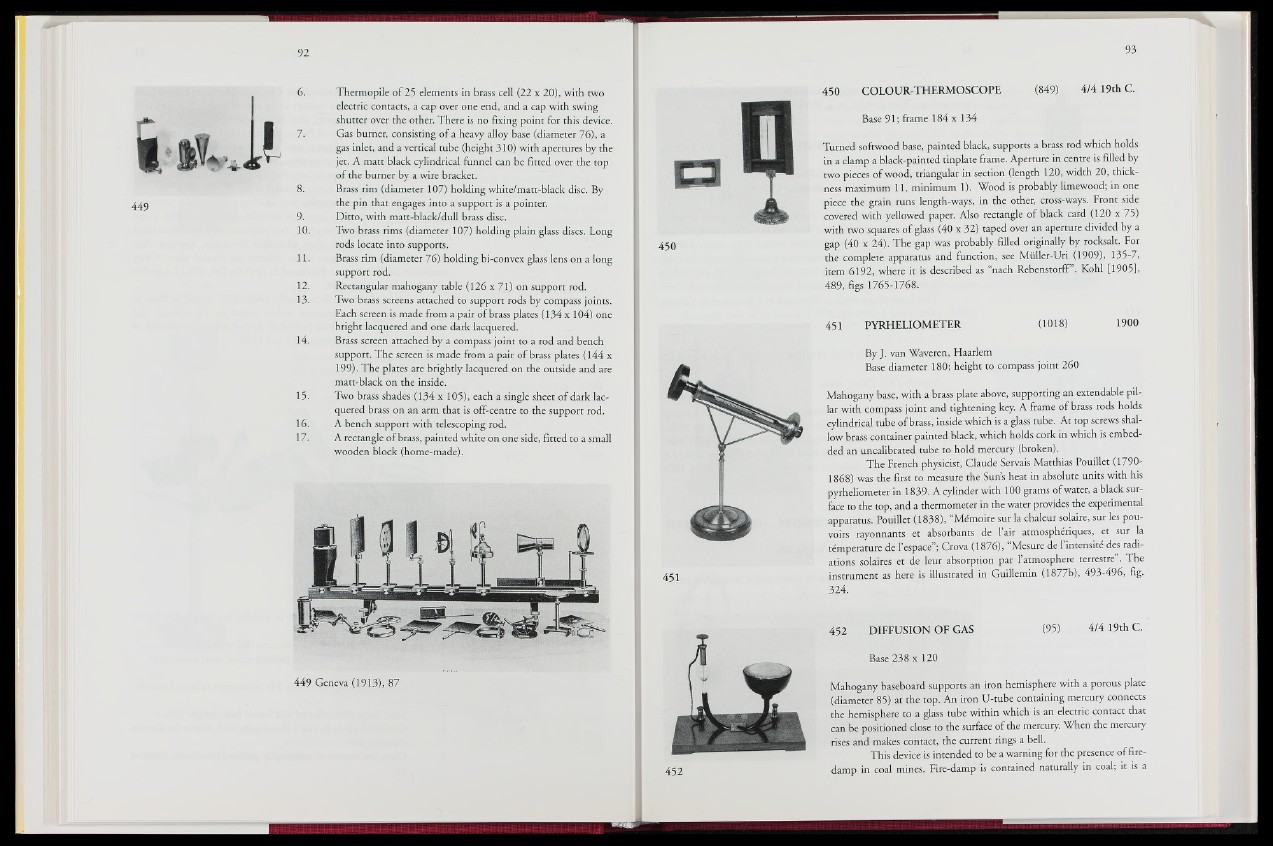
Thermopile of 25 elements in brass cell (22 x 20), with two
electric contacts, a cap over one end, and a cap with swing
shutter over the other. There is no fixing point for this device.
Gas burner, consisting of a heavy alloy base (diameter 76), a
gas inlet, and a vertical tube (height 310) with apertures by the
jet. A matt black cylindrical funnel can be fitted over the top
of the burner by a wire bracket.
Brass rim (diameter 107) holding white/matt-black disc. By
the pin that engages into a support is a pointer.
Ditto, with matt-black/dull brass disc.
Two brass rims (diameter 107) holding plain glass discs. Long
rods locate into supports.
Brass rim (diameter 76) holding bi-convex glass lens on a long
support rod.
Rectangular mahogany table (126 x 71) on support rod.
Two brass screens attached to support rods by compass joints.
Each screen is made from a pair of brass plates (134 x 104) one
bright lacquered and one dark lacquered.
Brass screen attached by a compass joint to a rod and bench
support. The screen is made from a pair of brass plates (144 x
199). The plates are brightly lacquered on the outside and are
matt-black on the inside.
Two brass shades (134 x 105), each a single sheet of dark lacquered
brass on an arm that is off-centre to the support rod.
A bench support with telescoping rod.
A rectangle of brass, painted white on one side, fitted to a small
wooden block (home-made).
449 Geneva (1913), 81
Base 91; frame 184 x 134
450
Turned softwood base, painted black, supports a brass rod which holds
in a clamp a black-painted tinplate frame. Aperture in centre is filled by
two pieces of wood, triangular in section (length 120, width 20, thickness
maximum 11, minimum 1). Wood is probably limewood; in one
piece the grain runs length-ways, in the other, cross-ways. Front side
covered with yellowed paper. Also rectangle of black card (120 x 75)
with two squares of glass (40 x 32) taped over an aperture divided by a
gap (40 x 24). The gap was probably filled originally by rocksalt. For
the complete apparatus and function, see Müller-Uri. (1909), 135-7,
item 6192, where it is described as “nach Rebenstorff . Kohl [1905],
489,-figs 1765-1768.
451 PYRHELIOMETER 11018) 1900
451
By J. van Waveren, Haarlem
Base diameter 180; height to compass joint 260
Mahogany base, with a brass plate above, supporting an extendable pillar
with compass joint and tightening key. A frame of brass rods holds
cylindrical tube of brass, inside which is a glass tube. At top screws shallow
brass container painted black, which holds cork in which is embedded
an uncalibrated tube to hold mercury (broken).
The French physicist, Claude Servais Matthias Pouillet (1790-
1868) was the first to measure the Sun’s heat in absolute units with his
pyrheliometer in 1839. A cylinder with 100 grams of water, a black surface
to the top, and a thermometer in the water provides the experimental
apparatus. Pouillet (1838), Mémoire sur la chaleur solaire, sur les pouvoirs
rayonnants et absorbants de 1 air atmosphériques, et sur la
témperature de l’espace”; Crova (1876), Mesure de 1 intensité des radiations
solaires et de leur absorption par 1 atmosphere terrestre . The
instrument as here is illustrated in Guillemin (1 8 7 3 , 493-496, fig.
i im .1
452 DIFFUSION OF GAS (95)1 4/4 19th C.
Base 238 x 120
Mahogany baseboard supports an iron hemisphere with a porous plate
(diameter 85) at the top. An iron U-tube containing mercury connects
ithe hemisphere to a glass tube within which is an electric contact that
can be positioned close to the surface of the mercury. When the mercury
rises an d makes contact, the current rings a bell.
This device is intended to be a warning for the presence of firedamp
in coal mines. Fire-damp is contained naturally in coal; it is a